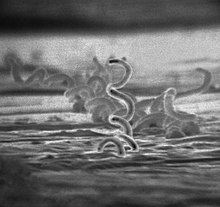
Back لولبية شاحبة Arabic لولبيه شاحبه ARZ Бледа трепонема Bulgarian Treponema pallidum BS Treponema pàl·lid Catalan Treponema pallidum Czech Treponema pallidum Danish Treponema pallidum German Ωχρά σπειροχαίτη Greek Treponema pallidum Spanish
| Treponema pallidum | |
|---|---|

| |
| Scientific classification | |
| Domain: | Bacteria |
| Phylum: | Spirochaetota |
| Class: | Spirochaetia |
| Order: | Spirochaetales |
| Family: | Treponemataceae |
| Genus: | Treponema |
| Species: | T. pallidum
|
| Binomial name | |
| Treponema pallidum | |
Treponema pallidum, formerly known as Spirochaeta pallida, is a microaerophilic spirochaete bacterium with subspecies that cause the diseases syphilis, bejel (also known as endemic syphilis), and yaws. It is known to be transmitted only among humans[1] and baboons.[2] It is a helically coiled microorganism usually 6–15 μm long and 0.1–0.2 μm wide.[1] T. pallidum's lack of both a tricarboxylic acid cycle and processes for oxidative phosphorylation results in minimal metabolic activity.[3] The treponemes have cytoplasmic and outer membranes. Using light microscopy, treponemes are visible only by using dark-field illumination. T. pallidum consists of three subspecies, T. p. pallidum, T. p. endemicum, and T. p. pertenue, each of which has a distinct associated disease.[4]
- ^ a b Radolf JD (1996). Baron S (ed.). Treponema (4th ed.). Galveston (TX): University of Texas Medical Branch at Galveston. ISBN 978-0-9631172-1-2. PMID 21413263. NBK7716. Retrieved 13 February 2019.
- ^ Harper KN, Fyumagwa RD, Hoare R, Wambura PN, Coppenhaver DH, Sapolsky RM, Alberts SC, Tung J, Rogers J, Kilewo M, Batamuzi EK, Leendertz FH, Armelagos GJ, Knauf S (2012). "Treponema pallidum Infection in the Wild Baboons of East Africa: Distribution and Genetic Characterization of the Strains Responsible". PLOS ONE. 7 (12): e50882. doi:10.1371/journal.pone.0050882. PMC 3527465. PMID 23284649.
- ^ Norris SJ, Cox DL, Weinstock GM (2001). "Biology of Treponema pallidum: Correlation of Functional Activities With Genome Sequence Data" (PDF). JMMB Review. 3 (1): 37–62. PMID 11200228.
- ^ Centurion-Lara A, Molini BJ, Godornes C, Sun E, Hevner K, Voorhis WC, Lukehart SA (1 September 2006). "Molecular Differentiation of Treponema pallidum Subspecies". Journal of Clinical Microbiology. 44 (9): 3377–80. doi:10.1128/JCM.00784-06. PMC 1594706. PMID 16954278.
© MMXXIII Rich X Search. We shall prevail. All rights reserved. Rich X Search